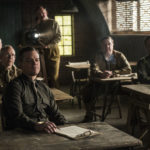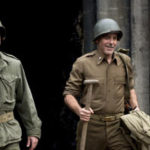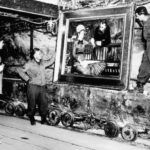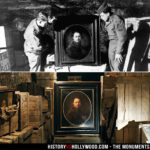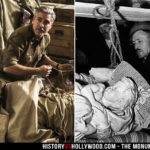“You can wipe out an entire generation, you can burn their homes to the ground and somehow they’ll still find their way back. But if you destroy their history, you destroy their achievements and it’s as if they never existed. That’s what Hitler wants and that’s exactly what we are fighting for”
There is without question a worthy film to be made about Nazis plundering and destroying art towards the end of World War II, and the detective work required to recover the priceless works of art – but George Clooney‘s Monuments Men is not it. This is a film struggling to find its own identity, neither one thing nor the other.
It tries hard to be a bittersweet tragicomic buddy movie and star vehicle for Clooney and his Hollywood mates, but then has to remember the weighty subject matter; it does not focus with any studious leanings on the works of art, but refers to them as if the audience were experts in art history; and it is another “based on” movie, which means that what you see is very heavily fictionalised, referring in passing to the extent of Nazi looting. Actually it’s based on a book by Robert M Edsel, of which more shortly.
This is a shame, because Clooney’s heart is in the right place. The characters are indeed based loosely on real people and the action on real incidents involving real works of art. His own character, Lt Frank Stokes, is based on a glamourised George L Stout, for example – which makes you wonder why he could not have stuck more closely with the truth?
Perhaps the main issue is that picking an all-star line up detracts from the real stars here – A Bridge Too Far syndrome as it is known. Clooney apart, we have in various roles Matt Damon, Bill Murray, John Goodman, Bob Balaban, Jean Dujardin, Hugh Bonneville AND (a very important “and”) Cate Blanchett as Rose Valland‘s alter ego. Hell, even Clooney senior gets in on the act!
Do Damon, Murray and Goodman look remotely like art experts? Not in a million years – they just do that thing each of them do; in Murray’s case, it’s to be drily witty with a deadpan face. Clooney and Damon can pretty much pull off any scenario with charm and grace, but Goodman and Murray look deeply uncomfortable and out of sorts, much as I said of the great Jack Lemmon playing Marcellus in Branagh’s Hamlet. Blanchett in a French accent sounds like… Blanchett in a French accent, not her most convincing performance.
As for plot, there is not that much to tell – essentially it’s a game of cat and mouse, into which a few subplots have been added to eke out the movie to a regulation 113 minutes. For the benefit of completeness, I’ve copied the Wikipedia description below, but in truth there is not that much to it, other than a recurring philosophical dilemma. Essentially it boils down to this conundrum: is art worth a life? Or to put it another way, are we led by philistines who fail to appreciate the value of art and the suffering to create and preserve it for centuries? Edsel’s answer is quoted in the link above:
“I think the best answer, though it is an individual answer, that characterizes the view of the Monuments Men, is that of Deane Keller, a Monuments officer who worked in Italy: ‘No work of art is worth the life of a single boy, but risking your life to fight for a cause is absolutely worth the effort.’ The Monuments Men felt across the board that for one person to run into a burning building to save a da Vinci, no, it’s not worth a single loss of life. But to risk your life for a way of life that includes respect for cultural property, yes, it is worth the risk. Indeed, two Monuments Men were killed during combat in World War II.”
The army view is that they would sooner save the life of a soldier than a work of art, but Clooney’s character’s response is at the head of this review. When a mine full of gold bars is recovered, Goodman’s Walter Garfield says: “The army may not care about art, but they sure as shit care about gold.”
Clooney’s view is also clear:
“It’s hard to write a script about saving art,” Clooney said. “It doesn’t sound all that fun, but it’s about culture, these monuments and about the fabric of the culture, our history and mankind’s way of recording history. And some would die for this.”
Maybe the greatest contribution Monuments Men makes, certainly greater than its entertainment value, is to question what art means to us, though I suspect that was lost on Studio Heads, for whom the value of gold is most certainly paramount. A satire on the film industry would be one possibly allegory to be drawn from the movie.
However, the fact is that what was recovered was the tip of the iceberg, and that many more priceless works of art were never recovered, some burnt and others presumably disappearing into private collections and bank vaults around the world. Some might resurface years later and go into auctions, at which point the provenance might be questioned, but many are presumed lost – but those in possession will not tell tales
One thing we know for sure is that excepting those looted from churches and galleries, most works recovered never ended back with their original owners, many of whom were Jews killed in concentration camps. It would have been a welcome addition were this fact added to MM’s closing titles.
___
In 1943, during World War II, the Allies are making good progress driving back the Axis powers in Italy. Frank Stokes (George Clooney) persuades the American President that victory will have little meaning if the artistic treasures of Western civilization are lost in the fighting. Stokes is directed to assemble a seven-man Army unit nicknamed the “Monuments Men”, comprising museum directors, curators, art historians, and an architect, to both guide Allied units and search for stolen art to return it to its rightful owners.
Claire Simone (Cate Blanchett), a curator in occupied France, is forced to assist Nazi officers, like Viktor Stahl (Justus von Dohnányi), in overseeing the theft of art for either Adolf Hitler‘s proposed Führermuseum in Linz or as the personal property of senior commanders like Herman Goering. While she is nearly arrested for helping her Maquis brother unsuccessfully recapture such items, all seems lost when she discovers that Stahl is taking all of her gallery’s contents to Germany as the Allies approach Paris. Simone runs to the railyard to confront Stahl, but can only watch as Stahl departs aboard the train carrying the precious cargo, standing defiantly as he futilely fires his pistol at her.
Stokes’ unit finds its work frustrated by its own side’s officers in the field, who refuse to endanger their own troops for the sake of his mission. James Granger (Matt Damon) finds that Simone will not cooperate with those whom she suspects want to confiscate the stolen art for their own country. The unit splits up to cover more ground, with varying degrees of success. Donald Jeffries (Hugh Bonneville), of the British Army, sneaks into Bruges, which is still occupied by the Germans, at night to try to save [[Michelangelo’s statue of the Madonna and Child. He is killed attempting to stop Colonel Wegner from taking it away.
Richard Campbell (Bill Murray) and Preston Savitz (Bob Balaban) learn that a Belgian panel set of religious artwork (Van Eyck‘s Ghent Altarpiece) was removed by the priests of Ghent Cathedral for safekeeping, but their truck was stopped and the panels taken. Eventually, purely by chance, they find and arrest Viktor Stahl, hiding as a farmer, when they identify the paintings in his house as masterpieces, at least one stolen from the Rothschild Collection. Walter Garfield (John Goodman) and Jean Claude Clermont (Jean Dujardin) get lost in the countryside and blunder into a firefight. Clermont is mortally wounded and dies when Garfield is unable to find medical help. Meanwhile, Simone reconsiders when Granger shows her the Nero Decree, which orders the destruction of all German possessions if Hitler dies or Germany falls, and sees Granger return a painting looted from a Jewish family sent to the death camps to its rightful place in their empty home. She provides a comprehensive ledger she has compiled that provides valuable information on the stolen art and the rightful owners.
Even as the team learns that the artwork is being stored in various mines and castles, it also learns that it must now compete against the Soviet Union, which is seizing artwork as war reparations. Meanwhile, Colonel Wegner is systematically destroying whole art caches. Eventually, the team has some success, as it discovers at least one mine hiding over 16,000 art pieces, as well as grotesque finds like barrels of gold teeth extracted from victims of the death camps. In addition, the team captures the entire gold reserves of the Nazi German national treasury.
Finally, the team finds a mine in Austria that appears to have been demolished. However, the team discovers that the entrances were blocked by the locals in order to prevent the Nazis from destroying the contents. The team evacuates as much artwork as possible, including the sculpture Jeffries died trying to defend, before the Soviets arrive to take control of what is to become part of the Soviet zone of occupation.
Stokes reports back to President Truman that the team has recovered vast quantities of artwork and various other culturally significant items. As he requests to stay in Europe to oversee further searching and restoration, Truman asks Stokes if his efforts were worth the lives of the men he lost. Stokes says they were. Truman then asks if, 30 years from then, anyone will remember that these men died for a piece of art. In 1977, the elderly Stokes (Nick Clooney), replies “Yeah,” while he takes his grandson to see Michelangelo‘s Madonna sculpture.


